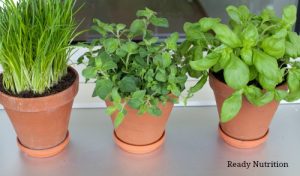
Having a successful garden is all about timing. Make sure you prep your starter soil, pots and the area where you plan to grow. If you don’t live in an area where there is heavy snow, begin cleaning and preparing your growing area. Here are some tips to get started [1].
Planting Conditions
So, what kind of herbs [2] are we talking about here? Chives, Cilantro, and Parsley, for starters, are perfect herbs for starting in the late winter. You’re going to start these guys indoors: seeds in general don’t germinate unless the mean temperature is at least 65 degrees Fahrenheit. In addition, you’re going to have to utilize as much of that sunlit side of your house as possible. When you throw these guys into pots (containers) and leave them in your windows? Give them some “setback” from the glass, as the cool air will linger up to about 1 to 1 ½ inches away from the glass.
Sunlight
You’ll need the sunlight, but not the cold up against the glass. You will have to be more inventive if you have closed off your windows with plastic, as this will stop some of the sunlight from reaching your sills. Your herbs will need at least 3 to 4 hours of direct sunlight (morning is preferable), and some indirect in the afternoon if it can be provided.
Naturally, if you have your greenhouse, then much of this becomes a moot point as long as allowance for sunlight and temperature are taken into consideration. You may need to heat the greenhouse, and this can be done in several ways: with electric heat/heat lighting, with manure/peat that generates organic heated “gassing,” or with a small wood stove. With this last option (as I’ve mentioned in past articles), it is very important to throw a teakettle (a noiseless one!) or a pot of water on the top of the woodstove. This will allow for some moisture and humidity, and your plants will appreciate this even more than you!
The factors to control are your water, your soil, and your drainage. An excess or inadequacy of any of these can lead to ruined herbs, whether you’re germinating your own seeds or whether you’re using cuttings.
Potted windowsills or potted greenhouses, take your pick and stick with it. Another thing you can do is in March, set up low-tunnels [3], with hoops made of plastic or aluminum and covered with plastic sheeting. These will enable maximum amounts of sunlight, and keep your cuttings or seedlings close to the ground.
Prepare the Garden Area Before Planting
Make sure you clear out an area for them that is sufficient. When the weather warms up so that your herbs (the hardier ones) can handle a frost, it’ll be time to transplant them into boxes. Anything on the ground should not be touching the ground directly, to prevent frost from entering. You mulched your perennials in the fall, and soon it will be time to start tending to them, such as garlic [4], for example.
All in all, potting your seedlings and/or cuttings is the way to go, either in the windows or in the greenhouses. Best thing to do is research your herbs prior to exposing them to the cold, as some herbs like basil cannot handle cold weather and fall over when the cold hits them. Plan according to the herb, and the zone in which you live, all of which can be determined either online or in your county extension office. So, start your herbs and planning for the spring…a few are “early risers” (such as the ones mentioned) that you can begin in the wintertime. Spring will be here before you know it, so get those green thumbs moving! We’d love to hear those “green thumb” comments about what you do, as they are valued by us and all of the other readers as well. Thumbs up, and happy winter herb gardening!
JJ
